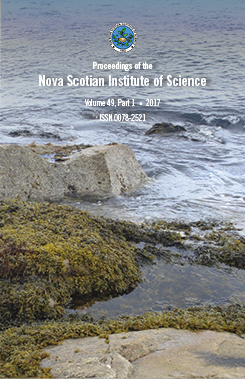A survey of the seaweeds of Lennox Passage and St. Peters Bay, Cape Breton Island, Nova Scotia
DOI:
https://doi.org/10.15273/pnsis.v49i1.6980Abstract
A novel, bay-scale (i.e. tens of km) survey method was employed to examine algal populations on the southwestern shore of Cape Breton Island, Nova Scotia. Since traditional remote sensing methods were unlikely to be successful in these waters, underwater video and acoustic methods were applied. A transponder positioned towfish housing video camera and sidescan sonar was hauled along predetermined transects perpendicular to shore to provide information on bottom type and algal cover. The towfish data were used to ground truth echosounder data (bottom type and macrophyte canopy height) collected along 5, 10 and 20 m depth contour lines. The survey area was divided into six zones comprising a range of exposure, depth and bottom types. Destructive quadrat samples were collected at each depth, plus shore stations, to provide biomass estimates. Over thirty taxa were enumerated, indicating depths and zones of common occurrence. Ascophyllum was abundant at some of the shore stations. The genera Chondrus, Cystoclonium, Desmarestia, Fucus, Phyllophora, Polysiphonia, and Saccharina were common at 5 m. Desmarestia and Saccharina dominated at 10 m with wet weights sometimes over 1 kg·m-2. Agarum dominated at 20 m. The towfish / echosounder grid sampling system was relatively coarse in order to cover the 140 km2 survey area within 12 days. As a result, the survey did not produce spatially detailed information. However, adequate information was gathered to describe the general characteristics of bottom type and algal cover by zone and for focussing further exploration.


